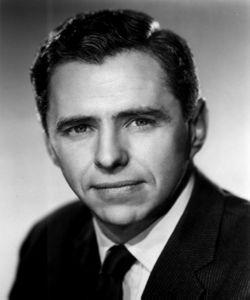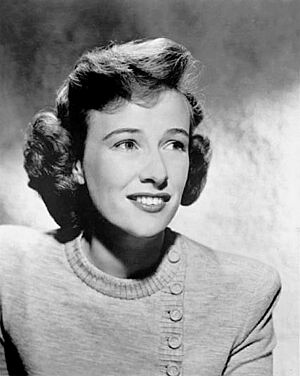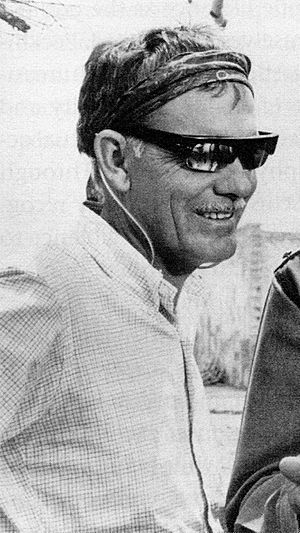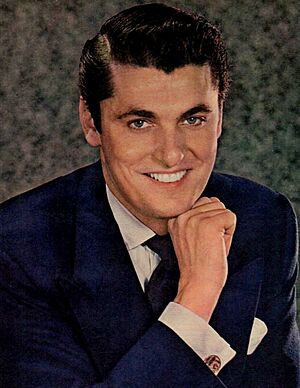James T. Aubrey facts for kids
Quick facts for kids
James T. Aubrey
|
|
|---|---|

Aubrey c. 1959
|
|
| Born |
James Thomas Steven Aubrey
December 14, 1918 LaSalle, Illinois, U.S.
|
| Died | September 3, 1994 (aged 75) Los Angeles, California, U.S.
|
| Alma mater | Princeton University |
| Occupation | Television and film executive |
| Spouse(s) | |
| Children | 2 |
James Thomas Aubrey Jr. (December 14, 1918 – September 3, 1994) was an American television and film executive. He was the president of the CBS television network from 1959 to 1965. During his time, he helped create some of TV's most popular shows. These included Gilligan's Island and The Beverly Hillbillies.
Under Aubrey's leadership, CBS became the top TV network in America. It had much higher ratings and profits than NBC and ABC. In 1964, The New York Times Magazine called Aubrey "a master of programming." He was known for making tough decisions. This earned him the nickname "Smiling Cobra." He left CBS in 1965.
After leaving CBS, Aubrey worked as an independent producer for four years. In 1969, he was hired by Kirk Kerkorian to lead Metro-Goldwyn-Mayer (MGM). MGM was facing big financial problems. Aubrey cut costs and helped the company make money again. He resigned from MGM in 1973. He then kept a low profile for the rest of his life.
Contents
Early Life and Career
James Thomas Steven Aubrey was born in LaSalle, Illinois. He was the oldest of four sons. His father was an advertising executive. James grew up in Lake Forest, a wealthy suburb of Chicago. He attended Lake Forest Academy, Phillips Exeter Academy, and Princeton University. All four Aubrey brothers went to these same schools.
At Princeton, Aubrey played on the football team. He was described as tall and handsome with a bright smile. He graduated in 1941 with honors in English. He then joined the United States Army Air Forces.

During World War II, Aubrey became a major. He taught military flying to actor James Stewart. While in Southern California, he met actress Phyllis Thaxter. They married in November 1944. Thaxter's final film role was as Martha Kent in Superman. They had two children, Susan and James. The couple divorced in 1962.
After the Air Force, Aubrey stayed in Southern California. He first sold advertising for magazines. His first job in broadcasting was selling ads for the CBS radio station KNX in Los Angeles. He soon moved to CBS's new TV station, KNXT. Within two years, Aubrey became the network's West Coast TV programming chief. He helped create the popular Western series Have Gun, Will Travel. Aubrey was then promoted to manager of all TV network programs in California.
In 1956, Aubrey moved to ABC. ABC was the smallest of the three major networks. Aubrey became ABC's head of programming. He brought many new and exciting shows to the air. These included the Walt Disney anthology television series. He also brought shows like Maverick and 77 Sunset Strip.
Aubrey's choices helped ABC become a strong competitor. He scheduled many successful shows. These included The Donna Reed Show, The Rifleman, and The Real McCoys. For the first time, ABC became a serious challenge to NBC and CBS.
Leading CBS Television (1959–1965)
Despite his success at ABC, Aubrey wanted to return to CBS. He came back to CBS in April 1958. He first worked as an assistant to Frank Stanton, the president of CBS. In April 1959, Aubrey became vice president for creative services.
Aubrey was named executive vice president in June 1959. This new role made him the second-highest official at the network. He oversaw all departments of the CBS Television Network. On December 8, 1959, Louis G. Cowan resigned as CBS president. This was due to his connection to the quiz-show scandals. Aubrey was appointed president the same day.
Aubrey was a very successful president for CBS for five years. He greatly increased the network's ratings and profits. In the 1963–64 season, CBS had almost all of the top-rated shows. This showed how dominant the network was under his leadership.
Aubrey's Programming Style
Aubrey's approach to programming focused on shows that were very popular with viewers. These included comedies like The Beverly Hillbillies and Gilligan's Island. Critics often disliked these shows. However, they were hugely popular with audiences. His former manager at ABC, Oliver Treyz, said Aubrey was "one of the most effective ever." He was great at giving the public what they wanted and making money.
The Beverly Hillbillies was a huge hit. Nielsen ratings showed that 57 million viewers watched the show. That was one out of every three Americans. Aubrey also made sure that the shows pleased CBS's advertisers.
His Management Style
Aubrey was known for making quick decisions. He was very controlling and worked long hours. He would read scripts, watch episodes, and even order changes to sets. Journalists said Aubrey used his power with great skill. By 1959, he was nicknamed "the Smiling Cobra" because of his tough approach.
Producer Merle Miller wrote about his experience working with Aubrey. He said Aubrey would often leave meetings without giving feedback. Miller learned that pleasing Aubrey was the most important thing. One producer called Aubrey "the most important man in television."
Aubrey's success made him more confident, but also more difficult to work with. He was often rude to people. This included network partners, advertisers, and even performers. Many people who had worked with him before found themselves excluded. Gossip columnist Liz Smith called him "a mean, hateful, truly scary, bad, outré guy."
For example, entertainer Garry Moore wanted to return to CBS. Aubrey told him "not a chance." Director John Frankenheimer, known for live TV dramas, was forced out by Aubrey in 1960. Frankenheimer later called Aubrey a "barbarian."
Lucille Ball, star of The Lucy Show, had disagreements with Aubrey. Aubrey also changed the schedule for Jack Benny's show without asking him. Benny, a long-time friend of CBS chairman William S. Paley, was unhappy. Aubrey told Benny his show would not be renewed. He said Benny was "through, old man." Benny moved his show to NBC, but it ended after one season. Aubrey also had disagreements with Red Skelton, Danny Thomas, Judy Garland, and Arthur Godfrey.
Allegations of Favoritism
There were claims that Aubrey showed favoritism in choosing programs. His friend Keefe Brasselle had little experience as a producer. Yet, Aubrey scheduled three shows from Brasselle's company for the 1964–65 season. These shows were The Baileys of Balboa, The Reporter, and The Cara Williams Show. None of these shows had pilot episodes.
Brasselle's shows quickly went over budget. The Reporter was $450,000 over budget after nine episodes. All three shows were not successful. When asked why he aired untested programs, Aubrey said, "arrogance, I guess."
Despite his tough style, Aubrey could be charming. He would go to great lengths to keep performers happy. To keep Jackie Gleason happy, CBS bought Gleason's futuristic home for $350,000. This was when Gleason moved his show to Miami Beach.
News and Sports
Aubrey often argued with officials at CBS News. He especially clashed with its chief, Fred W. Friendly. Friendly felt Aubrey did not care about news programs. Friendly said Aubrey talked about how expensive news was. He thought entertainment shows could replace news cheaply. However, Paley supported the news division. He protected it from Aubrey's proposed budget cuts.
In 1962, Aubrey ordered fewer special programs, including news. He believed interruptions to the regular schedule made viewers switch channels. Friendly did not like this decision.
In the fall of 1962, CBS Reports, a news documentary, was blamed for a drop in ratings for The Beverly Hillbillies. Hillbillies had been number one. But it dropped when CBS Reports aired before it. CBS moved CBS Reports to a different night.
Aubrey also warned that the high cost of sports rights could make them too expensive for TV. However, in January 1964, CBS agreed to pay $28.2 million to air National Football League games for two years. Aubrey said these games were important to viewers and advertisers. In April, he extended the deal for another year. By 1964, CBS was the top TV network for the tenth year in a row.
His Dismissal
In April 1964, a tabloid reported that Aubrey was taking favors from producers. The Federal Communications Commission (FCC) began to investigate. CBS learned that Aubrey's apartment was owned by a producer of CBS shows. Another producer was paying for a chauffeured car for Aubrey. CBS did not know about these arrangements. The company was also concerned about the money spent on Gleason's former home.
In late 1964, Aubrey suggested a plan to Stanton. He claimed he had investors ready to buy CBS. He said they would fire Paley, make Stanton chairman, and promote Aubrey to Stanton's job. This plan did not happen. Aubrey also showed disrespect for Paley in public. An Internal Revenue Service tax lien against Aubrey for $38,047.93 was another problem for Paley.
Aubrey's new shows for the 1964–65 season were not doing well. Paley ordered Stanton to fire Aubrey. This happened on February 27, 1965. The announcement was made the following Sunday. Stanton's statement praised Aubrey's accomplishments. However, no one gave a clear reason for his dismissal.
The New York Times Magazine wrote that Aubrey was fired due to his demanding style, falling ratings, and a lively personal life. Aubrey himself said, "I don't pretend to be any saint. If anyone wants to indict me for liking pretty girls, I'm guilty." After his divorce in 1962, he was known for dating famous women. His parties and dating became a topic of gossip.
John A. Schneider, who had no network TV experience, was named Aubrey's successor. CBS stock fell after the news. Aubrey remained a CBS employee until April 20.
After CBS (1966–1968)
Aubrey left CBS with $2.5 million in network stock. He moved to the Sunset Strip and started his own production company. In 1967, his lawyer tried to buy ABC for Howard Hughes. Aubrey was supposed to run ABC if the deal went through. However, Hughes refused to testify, and the deal failed.
Aubrey's reputation and dramatic exit from CBS inspired characters in three novels. His former friend Keefe Brasselle wrote The CanniBalS (1968). Harold Robbins's The Inheritors (1969) and Jacqueline Susann's The Love Machine (1969) also had characters based on him. Susann said Aubrey was "one of those people who are born to run the works."
In June 1967, Aubrey signed a two-year contract to produce films for Columbia Pictures. He said he had "no desire ever again to become involved in the corporate side of the entertainment business." He was also involved in other businesses, like real estate. His first project for Columbia was an adaptation of a Patricia Highsmith book.
Leading MGM (1969–1973)
Aubrey returned to the spotlight in 1969. This was when Las Vegas businessman Kirk Kerkorian took control of Metro-Goldwyn-Mayer (MGM). Aubrey's lawyer recommended him for the MGM president job. Aubrey was announced as MGM president on October 21, 1969. He was the studio's third president that year. MGM had lost $35 million in the previous year.
Aubrey received a salary of $4,000 a week. He said he wanted Kerkorian to be able to fire him easily if things didn't work out. MGM, like most big studios, was struggling. Kerkorian wanted Aubrey to bring the company back to its former glory. Instead, Aubrey largely sold off parts of the company. Kerkorian wanted to turn MGM into a hotel and casino business. Aubrey said the company was in "total disarray."
Within days of starting, Aubrey canceled 12 films to cut costs. He fired 3,500 employees when he moved headquarters to Culver City. He ordered the sale of MGM's historical collection of costumes and props. These included the ruby slippers from The Wizard of Oz. Most of the studio's backlot was also sold. Aubrey was criticized for selling off the company's history. He said, "To us they had no value."
His actions greatly improved the company's finances. In his first nine months, he cut MGM's debt by $27 million. The company made a profit of $540,000 in those nine months. This was a big change from the huge losses before.
Streamlining Operations
MGM had lost a lot of money. Aubrey said, "Basically what we're really concentrating on at the moment is to really streamline this operation." He planned to quickly produce films that cost no more than $2 million each. Many of these films were not successful with critics or audiences.
One success was the film Shaft. It cost $1 million and made about $12 million at the box office. Agent Sue Mengers said Aubrey was a very tough negotiator. Early on, Aubrey canceled two Julie Andrews films. He said the trend for musicals had ended. He also tried to cancel or reduce the budget for David Lean's Ryan's Daughter.

In the first half of 1970, the company made a $6.5 million profit. Aubrey said the company would have made money if not for four expensive films. These films included Goodbye, Mr. Chips and Zabriskie Point. These four movies cost almost $20 million and did not make their money back.
By the end of the fiscal year, the company made a profit of $1.5 million. This was a remarkable turnaround from the $35 million loss a year before. In January 1971, Aubrey said, "we are pleased that the company has been turned around." He announced the company was in merger talks with 20th Century Fox. However, Fox denied any negotiations.
Practical Approach to Filmmaking
Aubrey was very involved in MGM's films. He personally made edits to movies. The New York Times Magazine wrote that Aubrey's involvement was much deeper than at CBS. Director Herbert B. Leonard publicly protested Aubrey's edits to his film Going Home. Director Blake Edwards was angry about changes to Wild Rovers. He said Aubrey "cut the heart right out of it." Television producer Bruce Geller had his name removed from his first film, Corky, because of Aubrey's edits.

Aubrey also had a famous disagreement with director Sam Peckinpah. This was during the making of the Western Pat Garrett and Billy the Kid. Aubrey cut Peckinpah's budget and later cut nearly 20 minutes from the film. An editor said Aubrey cut scenes just because he knew Peckinpah didn't want them cut.
MGM had disagreements with the Motion Picture Association of America (MPAA) over film ratings. MGM left the MPAA in 1971. In October 1971, MGM announced plans to build the world's largest hotel in Las Vegas. This was the MGM Grand Hotel. The next month, the company announced profits of $16.3 million for 1971. This was the highest profit in 25 years.
After four years at MGM, Aubrey announced his resignation. He said, "The job I agreed to undertake has been accomplished." Kerkorian was named his successor in October 1973. Time magazine said Aubrey made profitable, medium-budget films. Directors often criticized him for interfering. But as a financial leader, Aubrey was very successful.
Final Years (1974–1994)
In the mid-1970s, Aubrey and Sherry Lansing were hit by a car while crossing a street. Both were injured. Lansing was on crutches for a long time. Aubrey helped her recover. Lansing said he came every day and gave her great support.
Aubrey became an independent producer after leaving MGM. He produced 10 films that were not very memorable. His biggest success was a 1979 TV movie about the Dallas Cowboys Cheerleaders. It starred Jane Seymour. In the mid-1980s, he was chairman of Entermark. This company made low-budget films. Aubrey said they could make a good profit on movies costing $3 million.
Gossip columnist Liz Smith reported rumors that Aubrey might return to lead CBS. This was after Paley left the network in 1986. Aubrey worked as a consultant for Brandon Tartikoff in the 1980s and early 1990s. Tartikoff was working to improve NBC's reputation. James T. Aubrey died of a heart attack in 1994.
|


